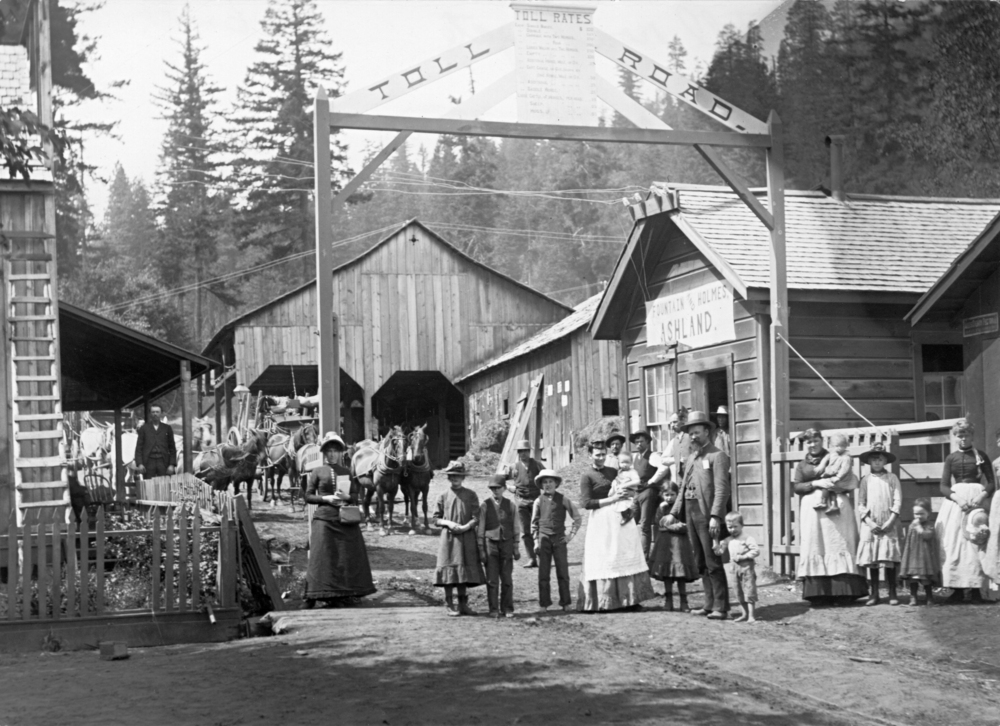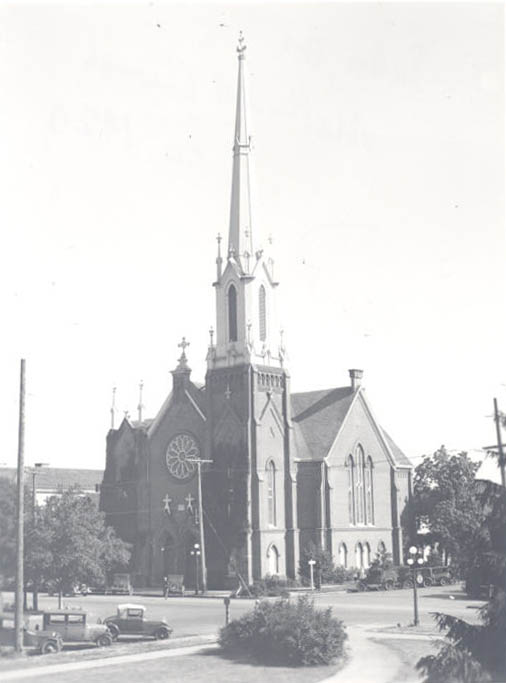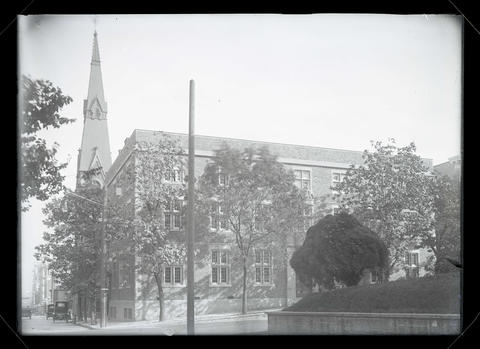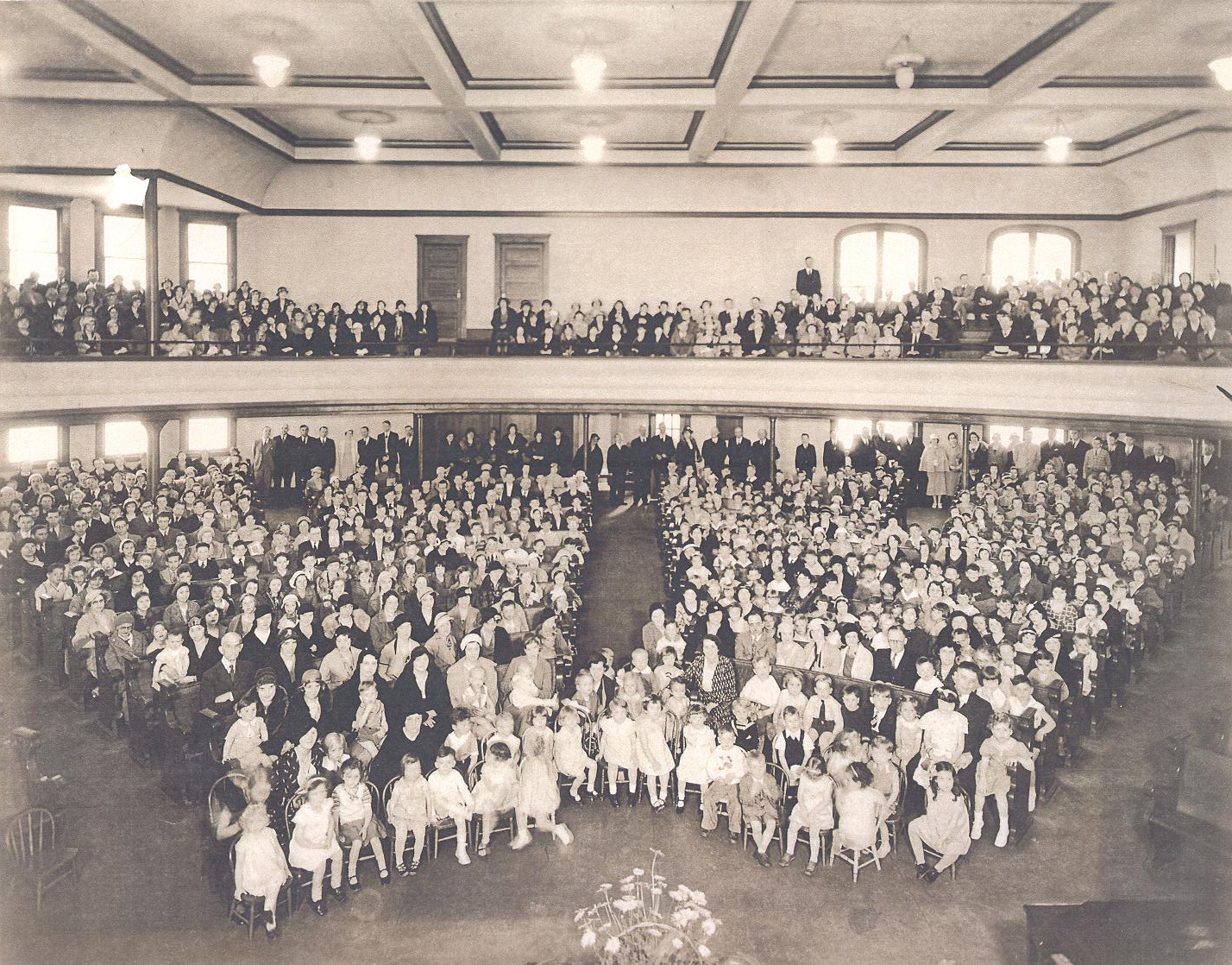The First United Methodist Church was the first permanent church building in Ashland. With stained glass windows crafted by the Povey Brothers of Portland, it is one of the city's most beautiful and culturally significant landmarks. The church is a contributing property of the Skidmore Academy Historic District, which was placed on the National Register of Historic Places in 2001. The district constitutes the city’s oldest residential area, where development began in the 1860s, a time when local Methodist families met in their homes with a circuit-rider preacher.
In July 1864, under the leadership of Rev. Philip M. Starr, fourteen Methodist families began to raise money for the construction of a normal school, a college, and a church. In 1872, Rev. Joseph H. Skidmore opened the Ashland Academy. The original church was constructed between 1875 and 1877 at 175 North Main Street, northwest of downtown Ashland. A simple one-story, white clapboard structure, the building served the Methodist community until a windstorm toppled the steeple on March 10, 1904.
Beginning in 1908, the present church was largely rebuilt on the stone foundations of the earlier church in an eclectic mix of the Queen Anne and craftsman styles. The primary eastern façade features a broad gable with a large central arch of stained glass. Above the original main entrance, at the northeastern corner, is a square bell tower. The exterior walls are white clapboard, with decorative shingles in a contrasting gray tone. In 1987, Rev. Nevitt Smith oversaw the construction of a large assembly space, Wesley Hall. Between 2006 and 2008, during the tenure of pastor Rev. Michael Powell, Wesley Hall was connected to the church with an addition to the western side of the historic structure, which is now the main entrance to the sanctuary.
The interior of the church is oriented with the front altar to the south and a rear balcony with balustrade to the north. An elegant tin ceiling with embossed white tiles displays interlaced and crossed acanthus patterns. A Reuter pipe organ, installed in 1929, is located behind the altar. Pipes were added to the instrument in 1989, and a polished brass Fanfare Trumpet made by Hochhalter was installed in 2004 in honor of Beverly Smith, wife of the pastor Rev. Smith. The church is known for its music programs.
Twenty-six stained glass windows were crafted for the church by the Povey Brothers of Portland. The glass, imported from Kokomo, Indiana, was designed, painted, and assembled in Povey’s studio, and the windows were installed during the 1908 rebuilding project. The large façade arch consists of a set of four stained glass windows with Christ Praying in the Garden of Gethsemane at the top. Most of the other windows feature Art Nouveau designs as well as selected Christian motifs such as the Alpha and the Omega, a dove, a sheaf of wheat with a scythe and rake, and crosses. A pair of windows to the west of the altar features a commemorative inscription: “In memory of the pioneer founders of this Church, who builded [sic] better than they knew.”
A project to restore the church’s historic windows was led by Linda Rae Barker Monroe, who was chair of the board of trustees from 2009 to 2013. Between 2010 and 2014, Tim and Dal Yockey of the Canterbury Stained Glass Company of Ashland replaced individual pieces of cracked glass and strengthened each window by adding new lead and solder.
One of the church’s best-known pastors was Rev. J. Ross Knotts (1950-1957), who founded the church’s Camp Latgawa in Eagle Point in 1953 and was known for his progressive, open-minded perspective. During his tenure, Ashland was a “sundown town,” and nonwhites were required to leave the city before sunset. One day an African American family's car broke down in Ashland. No one would assist them except Knotts, who gave the chief of police a sermon about helping one’s fellow man. His legacy carries on in the church, which became a Reconciling Congregation in 2008, open to everyone regardless of race or ethnicity, political persuasion, socio-economic background, or sexual orientation.
-
![]()
First United Methodist Church of Ashland, postcard c.1907-1915.
Courtesy Ann M. Nicgorski
-
![]()
First United Methodist Church of Ashland.
Courtesy Oregon State University Libraries
-
![Foundation cornerstone, 1908]()
First United Methodist Church of Ashland.
Foundation cornerstone, 1908 Courtesy Ann M. Nicgorski
-
![]()
First United Methodist Church of Ashland.
Courtesy Oregon State University Libraries
-
First United Methodist Church of Ashland.
Courtesy George S. Stellingwerf
-
First United Methodist Church, interior.
Courtesy George S. Stellingwerf
-
First United Methodist Church of Ashland, organ and altar.
Courtesy George S. Stellingwerf
-
First United Methodist Church of Ashland, interior.
Courtesy George S. Stellingwerf
-
First United Methodist Church of Ashland, east facade window.
Courtesy George S. Stellingwerf
-
First United Methodist Church of Ashland, east facade window.
Courtesy George S. Stellingwerf
-
First United Methodist Church of Ashland, window.
Courtesy George S. Stellingwerf
-
First United Methodist Church of Ashland.
East facade window with Christ detail Courtesy George S. Stellingwerf
-
![]()
First United Methodist Church of Ashland, north window wreaths.
Courtesy Ann M. Nicgorski
-
![]()
First United Methodist Church of Ashland, interior celing.
Courtesy Ann M. Nicgorski
Related Entries
-
![Ashland]()
Ashland
Ashland, a city of 21,360 people in Jackson County, is situated in the …
-
![First Methodist Church (Salem)]()
First Methodist Church (Salem)
Founded in 1841 by Jason Lee and members of the Methodist Episcopal Chu…
-
![First Presbyterian Church (Portland)]()
First Presbyterian Church (Portland)
First Presbyterian Church of Portland, organized in January 1854 just t…
-
![First Unitarian Church (Portland)]()
First Unitarian Church (Portland)
In 1866, the Ladies Sewing Circle, a small group of Portland women from…
-
![Hinson Memorial Baptist Church]()
Hinson Memorial Baptist Church
The year was 1857, two years before Oregon statehood, when a group of c…
-
![North Palestine Baptist Church (Benton County)]()
North Palestine Baptist Church (Benton County)
Modest country churches are rare on the twenty-first century Oregon lan…
Map This on the Oregon History WayFinder
The Oregon History Wayfinder is an interactive map that identifies significant places, people, and events in Oregon history.
Further Reading
Darling, John. "150 Years of Faith: Ashland's First United Methodist Church Celebrates Notable Anniversary." Ashland Daily Tidings, July 10, 2014.
Eastman, Janet. “Church Volunteer Leads Effort to Restore Historic Church’s Stained-Glass Windows.” Ashland Daily Tidings, August 27, 2013.
Kramer, George, with Katherine C. Atwood. “Skidmore Academy Historic District.” Nomination Form for the National Register of Historic Places (2000).
Lewis, Graham. “This Old House of Worship.” Ashland Daily Tidings, May 3, 2004.
O’Harra, Marjorie. Ashland: The First 130 Years. Jacksonville, Ore.: The Southern Oregon Historical Society, 1981.
O’Harra, Marjorie. The Ashland Story. Ashland, Ore.: Lewis Osborne, 1971.
Peterson, Joe. Ashland. Charleston, South Carolina: Arcadia Publishing, 2009.























